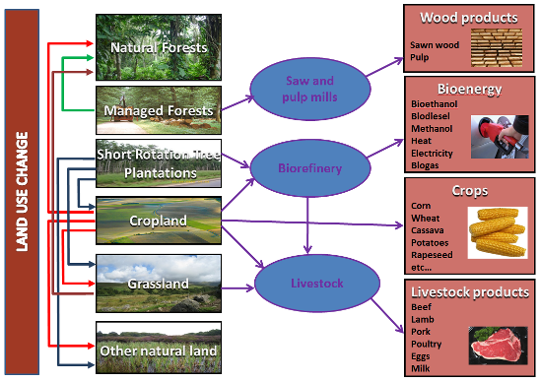GLOBIOM Supply Chain

Agricultural Sector
Crops
GLOBIOM covers 18 major crops, which represented about 80 % of the 2007 global harvested area. These include Barley, dry beans, cassava, chick peas, corn, cotton, groundnut, millet, potatoes, rapeseed, rice, soybeans, sorghum, sugarcane, sunflower, sweet potatoes, wheat and oil palm. Four management systems are considered (irrigated, high input – rainfed, low input – rainfed and subsistence) corresponding to the IFPRI crop distribution data classification.
Crop supply can enter one of three processing/demand channels: consumption, livestock feeding or biofuel production. Consumption demand is modeled by constant elasticity functions. Biofuel options from crops include first generation technologies for ethanol from sugarcane, corn and wheat, and biodiesel from rapeseed, palm oil and soybeans.
EPIC
EPIC has been set up and is used to perform global runs for GLOBIOM by Erwin Schmid from the University of Natural Resources and Applied Life Sciences, Vienna (BOKU).
The major EPIC outputs used in GLOBIOM are the management specific spatially explicit crop yields, fertilizer and irrigation rates, and environmental impacts like nitrogen leaching.
Livestock
Production system based livestock representation has been recently developed in colaboration with the team of Mario Herrero from the International Livestock Research Institute (ILRI). The model differentiates between 14 production systems consistent with the ILRI/FAO production system classification.
RUMINANT
Input-output-parameters for ruminants are etimated through the RUMINANT model (Herrero et al., 2008)1. It is a dynamic simulation model of digestion in ruminants largely based on IPCC methods. It predicts intake, production (meat and milk), and excretion as well as metabolism end products (methane, volatile fatty acids, etc...).
Bioenergy
there is info missing......
Forest Sector
Three kinds of forests are distinguished in the model: unmanaged forests, managed forests and short rotation tree plantations. Managed forests and short rotation tree plantations are used for wood production.
Five primary products can be harvested from managed forests: saw logs, pulp logs, other industrial logs, firewood, and energy biomass. Saw logs and pulp logs are further processed to produce sawn wood and pulp wood. The energy biomass, which can also come from short rotation tree plantations, can be used in bioenergy chains for polyproduction of ethanol, methanol, heat and power, and biogas mixes.
G4M
The Global Forestry Model (G4M) is primarily a geographically explicit agent-based model to assess afforestation-deforestation-forest management decisions at the 30 arcmin grid level. Since it relies on many in-house produced parameters, it is also source of data for other models.
The most important parameters for GLOBIOM that are taken from G4M are mean annual increment, maximum share of saw logs in the mean annual increment, and harvesting cost. These parameters are estimated based on the information about the above ground carbon in forests from FRA2005, downscaled for our purposes as described in Kindermann et al. (2008)2.
1 Herrero, M., Thornton, P.K., Kruska, R. and Reid, R.S. (2008). Systems Dynamics and the spatial distribution of methane emissions from African domestic ruminants to 2030. Agriculture, Ecosystems and Environment 126: 122-137. [download]
2 Kindermann, G.E., McCallum, I., Fritz, S. and Obersteiner, M. (2008). A global forest growing stock, biomass and carbon map based on FAO statistics. Silva Fennica 42: 387-396. [download]


